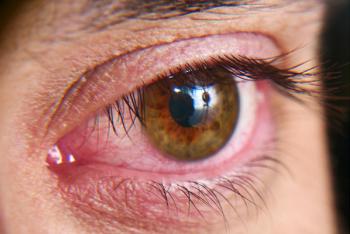
Treatment Options for Diabetic Retinopathy
Key opinion leaders discuss the recommended guidelines and available therapeutic options for the treatment of diabetic retinopathy.
Transcript
Robert Wong, MD: Pharmacological, laser, or surgical treatment should be tailored for every patient with diabetes depending on the eye condition. Anti-VEGF [anti-vascular endothelial growth factor] therapy is now the mainstay standard of care for most patients with diabetes. In fact, the FDA recently approved the use of anti-VEGF medications for all forms of diabetic retinopathy. For patients with diabetic macular edema that is affecting vision, it depends on the vision. For some patients who see very well, such as 20/20 or 20/25 vision, they may be observed. If they are observed, I typically follow them very closely with diagnostic testing such as an OCT [optical coherence tomography], perhaps every 3 months.
For patients whose vision has dropped to 20/40 with diabetic macular edema, the guidelines suggest that prompt anti-VEGF therapy would be warranted. For patients with more severe diabetic retinopathy with no macular edema, they may be watched, or it’s reasonable to treat those to reverse the diabetic retinopathy. There are several studies that have shown that continuous treatment with anti-VEGF therapy has improved the diabetic retinopathy severity score.
For patients with proliferative disease, I often treat patients with either anti-VEGF therapy or panretinal photocoagulation. Panretinal photocoagulation is the standard of care because the laser treatment targets areas of ischemic retina in the periphery, and it can also reverse the disease. However, there are new studies that show that treatment with anti-VEGF therapy may be just as good as panretinal photocoagulation. It can also reduce the risk of the complications from laser treatment by reducing the risk of night vision loss and visual field loss. For any patient with diabetic macular edema and proliferative diabetic retinopathy, the guidelines suggest that prompt anti-VEGF therapy is favorable.
For patients who have a vitreous hemorrhage, which may preclude treatment of the retina, there are several options. One option is to treat with anti-VEGF therapy to make the neovascular blood vessels shrink so the bleeding can clear on its own. For patients with persistent, non-clearing vitreous hemorrhages, surgical options exist. Vitrectomy surgery is wonderful at clearing out that vitreous hemorrhage, allowing us to perform panretinal photocoagulation.
Jose Martinez, MD: We have many treatment options to handle patients with diabetic eye disease. Ideally, we try to treat patients before they have significant symptoms, and we can prevent the need for more aggressive therapies. We usually start treating patients with anti-VEGF injections that have hit the market in the last 5 years. Multiple studies have shown the benefit in patients not only to reduce their risk of vision loss but to reduce the severity of diabetic retinopathy in their eyes as well.
Previously with laser treatments, which used to be the standard of care, we could never reverse the severity of the diabetic retinopathy; all we could do was treat the causes of vision loss. Now we’re able to not only treat the causes of vision loss, but we’re able to reverse the degree of severity as well, making it less likely patients will need further treatment.
If patients have advanced disease due to diabetic tractional retinal detachment, which occurs when the proliferative diabetic retinopathy has formed a disease where abnormal blood vessels start growing in the back of the eye. Those abnormal blood vessels bleed and scar, and that scarring can lead to tractional retinal detachments where the retina is being pulled off the eye wall due to the scar tissue. That is treated with surgery. That’s advanced disease, but thankfully, we have surgical techniques called diabetic vitrectomy where we’re able to help most of those patients. In severely advanced cases where patients show up to us with limited vision and severe tractional retinal detachments, it’s much more difficult to regain some of their vision. The goal of treatment is to prevent patients from ever getting to that stage, and if they get timely intervention, we can prevent them from getting there.
Over the year since the introduction of anti-VEGF injections, the rate at which patients need diabetic vitrectomy or surgery has gone down quite dramatically because those injections prevent them from ever reaching that stage.
That’s why it’s so important that these patients be screened in a timely fashion because we can prevent vision loss and ultimately reduce the cost of caring for these folks: not only the medical cost, but also all the indirect costs that come from impaired vision, whether it be paying disability, paying unemployment, or whatever it might be.
Newsletter
Stay ahead of policy, cost, and value—subscribe to AJMC for expert insights at the intersection of clinical care and health economics.








































